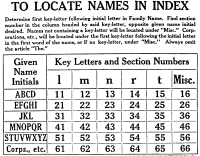In this article, you will find:
Page 2
Making Sense of the Index
Open the index book, and see if it is a standard index and easily understood. There should be a diagram or chart and an explanation of the indexing system used in that county. Read it carefully. If, after a few minutes, you are still unsure, ask the clerk to explain the system.

In the figure, using the so-called Russell system of indexing, go to the index book with the initial letter of the surname you are tracing. Then determine the first key letter as listed at the top of the figure (l, m, n, r, or t), to find where in the deed books the surname is indexed. For example, if the surname is Martin, then you are searching in the M index. Ignoring now the initial letter of the surname (you are already in the M book), search for the first key letter. The next letter is a, not one of the key letters (l, m, n, r, and t), so it is ignored. The next letter, r, in Martin, is the first key letter of that name. Looking at the columns, you note that Martin is therefore indexed on pages 14, 24, 34, 44, 54, and 64.
In the left column of the same figure, the letters ABCD, EFGHI, and so on, represent the initials of the given name. If you are searching for Abraham Martin, go to page 14 of the index. If you are searching for Mary Martin, proceed to page 44 of the index.
If you are searching a name such as Rowse in the Russell system of indexing, because there are no key letters (l, m, n, r, or t) following the initial letter of R, you would use the Miscellaneous column. (Anything not falling within the key letters is considered miscellaneous.) Abraham Rowse would be on page 16, while Mary Rowse would be on page 46. The Russell index, though prevalent (and still in use), is only one of numerous types of indexes.
What Should You Note?
After you determine how to use the index, look for entries that involve your family. The indexed entry will include the name of the grantor and grantee along with the date of the document, date recorded, type of document, book and page where it is recorded, and perhaps a very short property description showing the township, lot number, waterway, or other brief designation.
While you search the index, note the column that designates the type of deed. Typical designations might be warranty deed, deed of trust, gift deed, power of attorney, partition, or others. Each is a specific way of conveying land or rights. You will, in the course of your research, become familiar with all these terms and understand the value of each.
10 Ways to Help Your Kid Get Organized for the New School Year
Developing good organizational skills is a key ingredient for success in school and in life. Read More
Be sure to note the reference given in the index: the book or volume number and the page number. You will need this to find the document. Note, too, the type of document.
Lineage Lessons
When you find the book and page reference, take note of any abbreviations that appear immediately before the volume number. There may be separate volumes for specialized records. For example, “PA” (Power of Attorney), “DT” (Deed of Trust), or some other designation, might precede the volume number.
Search Strategies in Deeds
While you are working with the deeds, take some time to copy all the index entries for your surnames of interest in the appropriate time period. If, after you return home, you find that you need another deed, you can order it by mail, citing the book and page number. (Or you may be able to order microfilm of the records from the Family History Library.)
Be particularly alert to indexed entries that appear to involve several people. They could be family members. The words et al. (“and others”) can be a tip-off to such transactions. If the document is designated Power of Attorney, Gift Deed, or Partition (involving divisions), or if an estate is mentioned, then you should take the time to examine it. These types of documents often show familial connections.
Is He Augustus W. Redman, A. W. Redman, or Gus?
Consider possible alternate versions of the first or given name. This will include initials, first and middle name reversed, and even nicknames. George Washington Smith may be found as George, as Washington, G. W., George W., Washington G., W. G., G. Washington, and Wash. It will be important to know all the variations. If you don't know that Patsy was a nickname for Martha, Nabby for Abigail, Jane and Jennie for Virginia, Polly for Mary, and others, you may miss the listing you are seeking. Christine Rose's Nicknames Past and Present includes many hundreds of nicknames, all cross-indexed.
Tree Tips
If the early deed books started with A, B, and C, the set following after the letter Z may begin with 1, 2, and 3; or, it may begin AA, BB, CC; or even 2A, 2B, 2C; and so on.
It's There Somewhere
You searched the index and noted a deed to what appears to be the old family farm, listed as Book B, page 510. Look around and see if you can find some books that are marked on their spines with the word “Deeds.” Watch for Books A, B, C, and so on.
It is permissible to remove a deed book from the shelf and put it on the counter for examination, but be sure to put it back (in the same spot) when you are finished. The counters on which you will be working are usually high and slanted. Other researchers (perhaps title searchers from the local land title companies, attorneys, or other genealogists) will be working there, also.
Use as little counter space as possible. If you have a coat, hat, umbrella, or briefcase, find a spot off the counter to place them; counter space is generally limited.
Finally … It Is in Hand
After you find the Deed book you seek, turn to the page you noted from the index. The document you want should start on the indexed page. Follow it through to the end, which may be several pages later. In Transcribing and Summarizing Genealogical Documents you learned about transcribing and abstracting. Use those techniques to get the information, or if you wish to have a copy of the entire document, ask the clerk about photocopying costs and procedures. The fees vary but usually are nominal.
